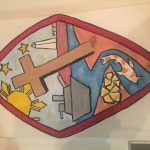When I first heard that our HIUS144 class was visiting Chicano Park for a field trip, I did not know what to expect because I had never visited it. I moved to San Diego three years ago, and I honestly have rarely heard anything about the park- where it was located, what its significance was, who founded it, etc. As I stared out the bus windows trying to see where this place was located, I was stunned to find that we had stopped at the bottom of the freeway. Looking at the vibrant paintings that adorned the walls of this small space, I realized that I had made it to Chicano Park.
If you were to ask me, or maybe any other American, what characteristics they associate with parks, they would probably shout words along the lines of greenery, monuments, wide space, trees, plaques, or statues. Upon arrival to Chicano Park, I noticed none of these; rather, it was the complete opposite in that it was concrete, narrow, confined, and loud. These adjectives alone would have some people arguing that this does not characterize a park, but I thought that it was these things that validated it as a park.
In my eyes, a park should embody the essence of the environment it is in. It is an expression of the people and communities that reside there. This is what Chicano Park was to me. In an area that virtually no one would claim was desirable, they created art. These art pieces are not only artistic narratives of the people, but it also engages in dialogue with residents and visitors. Even if you are not a member of the community, you can feel the passion and exuberance when you see these paintings.
Chicano Park boasts the talent of the community while simultaneously fostering education. Contemporary norms deem that teaching should be done in a certain way, or that storytelling should be written by certain people and for certain people. The abundance of murals shows that learning is not limited to Academia in higher education or scholarly texts, but these paintings foster a community approach to learning and engagement. Chicano Park fosters collective discussion and interpersonal connections, which contrasts what many people believe is a more superior form of learning.
Chicano Park challenges what a park is and how education should be conducted, but it ultimately reflects the resilience and power of the community at large.
Ha’ani San Nicolas, 05/16/18





Yen Espiritu
May 16, 2018 — 9:52 am
Beautifully written!